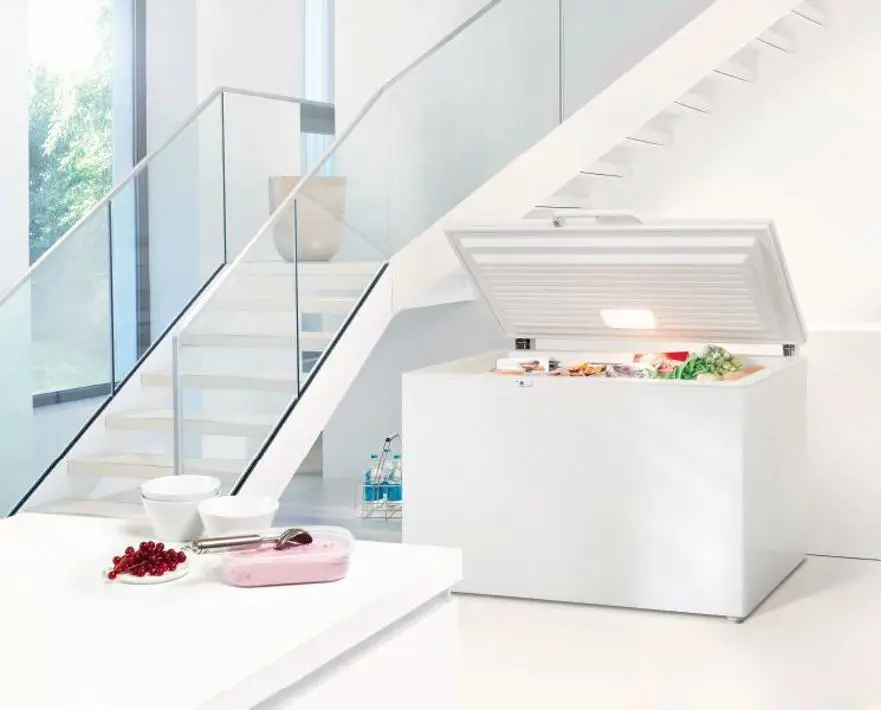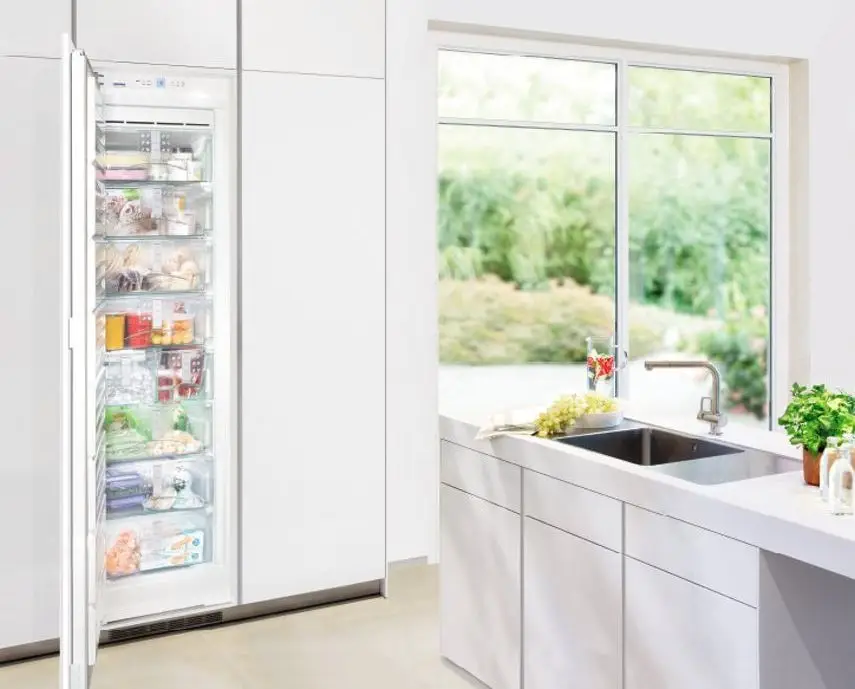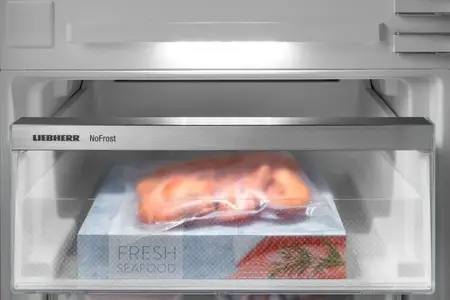If you’re planning to purchase a freezer, you may be wondering whether to choose a chest freezer or an upright freezer. To help you with this decision, we’d like to provide you with all the essential information on this topic.
One thing is clear: chest freezers and upright freezers serve the same purpose, namely deep freezing and thus longer-term storage and preservation of food supplies. And unlike the freezer compartment in a refrigerator or a combination unit, they also offer particularly ample space.
This is probably why you’ve decided to purchase one of these freezer specialists. If you’re still not completely sure whether a chest freezer or an upright freezer is the better choice for you, you’ll surely find the answer with the help of the following information.
Usable Volume, Space Requirements, and Placement of Chest and Upright Freezers
Due to their design, chest freezers and upright freezers obviously differ in their shape and size. As a result, they offer different amounts of usable volume, require different amounts of space, and can only be placed in suitable locations. Therefore, the factors of usable volume and space requirements are probably the most decisive when choosing between a chest freezer or an upright freezer.
Usable Volume and Storage Behavior
Generally, for low to medium food storage needs, a usable volume of about 50 to 80 liters is recommended for freezers, and for larger storage needs, up to 130 liters per person living in the household. To calculate the appropriate usable volume, you must first analyze your own usage behavior.
Those who freeze only small quantities would be better served by a smaller appliance, as larger appliances naturally consume more electricity. In this case, choosing an upright freezer is particularly suitable, as their usable volumes start from about 90 liters. On the other hand, those who want to store a lot of frozen goods should choose a correspondingly large appliance.
Upright freezers are available with usable volumes up to about 400 liters, while chest freezers have usable volumes between about 240 and 430 liters. If the following criteria allow it, a chest freezer is more suitable for larger food storage than an upright freezer, as it is more energy-efficient.
Wide Chest Freezers, Tall Upright Freezers
Chest freezers are about 80 to 90 centimeters high and between half a meter and one and a half meters wide. As the usable volume increases, they become increasingly wider. Upright freezers, on the other hand, are between 55 and 70 centimeters wide, mostly 60 centimeters, and about 80 centimeters to 1.80 meters high, thus becoming increasingly taller with greater usable volume.

Which is Better?
With their enormous width, chest freezers take up quite a lot of space, and additionally, the space above them is essentially wasted since it must remain clear for opening the lid. In often limited living space, especially in smaller kitchens, this much space is usually not available.
The basement is therefore more suitable for setting up a chest freezer. However, this also means that longer distances must be covered to store and retrieve supplies.
With upright freezers, on the other hand, vertical space is used much better in the form of storage space, while they usually only take up as much width as a normal kitchen cabinet. Consequently, upright freezers fit into almost any kitchen and thus keep frozen goods readily available where they are needed.
Free-standing and built-in appliances
Furthermore, chest freezers with their upward-opening lids cannot available as stand-alone units, but thanks to the front-opening door, many models can also be installed under counters or built in.

The design also has consequences for aesthetics. Chest freezers are available almost exclusively in plain white, which is often perceived as not very attractive for the appearance of the living space or kitchen. The situation is similar with free-standing upright freezers, which are only very rarely available in colors other than white.
The best choice for a uniform design would therefore be a built-in upright freezer, as it can be clad with a matching furniture front and thus seamlessly integrates into the kitchen.
Energy consumption of chest freezers and upright freezers
Finally, energy consumption should also be considered when deciding between a chest freezer or an upright freezer. The chest freezer turns out to be the better choice, because due to its design with the upward-opening lid, it offers several advantages in terms of energy efficiency.
Through the upward opening, chest freezers primarily take advantage of the physical law that cold air is heavier than warm air. The cold air in the chest freezer therefore sinks to the bottom. When the lid at the top is opened, very little of the cold air at the bottom escapes.
After closing, the chest freezer has to cool less new air and consequently uses less electricity. With upright freezers that open to the front, much more cold air escapes, so they have to work considerably harder after closing and therefore require more energy. The heavy chest lid also ensures extremely good sealing, as its weight presses firmly on the chest freezer. This also contributes to energy savings.
Finally, chest freezers often have much thicker insulation since they are already large in size and a few more centimeters make no difference. Better insulated appliance walls naturally protect the cooling air inside more effectively from heating up, so the chest freezer has to provide far less cooling performance, and that in turn keeps power consumption low.
Upright freezers, on the other hand, usually have to conform to standard dimensions. Thicker insulation would come at the expense of the usable volume, meaning less frozen food would fit inside. For this reason, upright freezers are often not insulated quite as thickly, have to provide more cooling capacity accordingly, and therefore have higher energy requirements.
The following table illustrates as an example for a chest freezer and an upright freezer with the same usable volume of 237 liters and the same efficiency class of A++, how much more economical a chest freezer is.
As the example shows, a chest freezer can save about 20% in electricity costs annually compared to an upright freezer. This pays off every year and, of course, adds up over the long lifespan of a chest freezer of well over a decade. If the purchase price is also taken into consideration, it can be noted that for devices of similar size and the same efficiency class, it is also about the same or upright freezers are often even a bit more expensive. The electricity cost savings of the chest freezer therefore do not have to first offset a higher purchase price, but practically pay off immediately in cash.
In conclusion, however, we would also like to point out once again that larger appliances always consume more energy than smaller ones, which is why the usable volume should be very precisely defined. If a chest freezer is chosen because it has a relatively lower power consumption, but its large storage space is then not really filled, this costs unnecessary energy. A chest freezer is therefore only absolutely more economical if it is actually used as fully as possible.
Features of Chest Freezers and Upright Freezers
Due to their design differences, the two types of freezers differ not only in terms of space requirements and energy consumption but also in their features, which may also play a role in deciding between a chest freezer or an upright freezer. Chest freezers have baskets inside, while upright freezers are equipped with drawers.
However, both typically have interior lighting and a quick-freeze function, with higher-end models often featuring lid or door closing dampers. Furthermore, many chest freezers have a lid lock, whereas upright freezers rarely have a door lock.

The choice to buy a chest freezer or an upright freezer certainly depends somewhat on which features are more appealing and better suited to one’s own needs.
Conclusion on the Decision for a Chest Freezer or an Upright Freezer
Many factors influence the choice of freezer, and certainly not all of them are equally important to everyone. Depending on what is valued most, the decision for a chest freezer or an upright freezer should be made. Nevertheless, some summary recommendations can be given:
A chest freezer is the better choice,
if…
- you want to store a large amount of frozen goods.
- you have sufficient space for installation.
- you don’t mind the appearance (e.g., when installed in the basement).
- you can accept longer walking distances to store and retrieve supplies (e.g., when installed in the basement).
- you don’t necessarily need an automatic ice maker.
because…
- a chest freezer offers particularly large storage space.
- it is especially energy-efficient.
An upright freezer is the better choice,
if…
- you want to store little to moderate amounts of frozen goods.
- you don’t have much space for installation.
- you want to maintain a uniform kitchen design.
- you want to have frozen goods readily available in the kitchen.
- you need an automatic ice maker.
- you can accept higher energy consumption.
because…
- upright freezers also offer small and medium usable volumes for small to medium stockpiling.
- they fit into almost any kitchen in standard width.
- as built-in models, they integrate nicely visually.





